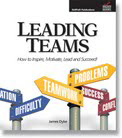The first “C” is COMMUNICATION—teams have to learn how to share information.
The second “C” is CONFLICT RESOLUTION—teams have to learn how to resolve their differences.
The third “C” is COLLABORATION—teams have to learn how to work together.
The fourth “C” is COMMITMENT—teams have to be committed to do the hard work it takes to have an effective team! What hard work??? The hard work of COMMUNICATION, CONFLICT RESOLUTION, and COLLABORATION!
I tell teams, “I can help you with the first three ‘C’s’ but I can’t help you with the fourth.”
That’s because first three C’s are strongly skill-based. In other words, team members can be TRAINED to talk, fight, and work together. My expertise as a consultant applies in this arena—training people is what I do!
The fourth “C,” on the other hand, is entirely a matter of individual mindset. It’s an attitude that team members either have or they don’t have; they either adopt it or reject it. It’s entirely up to the individual team member—the manager has no control whatsoever in this arena! (There is no such thing as mind control—any parent of a teenager knows this!)
Commitment to the team—its charter and its ultimate success—is a matter of individual personal determination. This is why a team leader must engage the entire team in drafting the Team Charter—it is the best way to gain each team member’s ultimate commitment and support.
This is also why author Larry Bossidy directs team leaders to hire to the vision. In other words, leaders need to recruit new team members who already “get” the vision of the organization and the team—candidates who understand and accept the vision and who can easily internalize it in their personal engagement and focus. (BTW…If this isn’t part of your strategy when you hire, it should be!)
The commitment of your team members also rests greatly on your credibility as a leader. In their excellent book, The Leadership Challenge, authors Kouzes and Posner reveal the thought-provoking insights of a study that researched the importance of a leader’s credibility.
They state,
In our studies we found that when people perceive their immediate manager to have high credibility, they’re significantly more likely to … Feel a strong sense of team spirit.
It should come as no surprise that your believability as a team leader is a major part of the glue that holds a team together. Especially in times of change, challenge, or crisis—your leadership becomes a rallying point for your team.
So… How do you gain essential commitment from your team members?
1. Start by including them in the drafting of your Team Charter. They will be much more likely to support it if they have a hand in creating it! I teach this principle in my management training seminars: P = O … in other words, Participation Produces OWNERSHIP.
2. Help them understand the reality (and value) of team success—that the team can’t be effective without the active support of every team member. Show them how their individual work is important to the overall effectiveness of the team as a whole. Then make sure they understand how the team’s work supports the ultimate success of the organization as whole. Help them see the link between their work and the impact it has on clients and customers.
3. Help them see how their success is tied to the success of the team. If the team fails, every member bears the consequences. Conversely… if the team succeeds, every team member enjoys the fruits of that success! You can help them make that connection when you…
4. Set team goals TOGETHER, with their input. Provide positive consequences for team success. Offer TEAM praise and affirmation (brag on your team’s success to YOUR boss — it’s good for you as well as good for your team!). Celebrate TEAM success — that sends the right message that “we’re all in this together.”
In one of my blogposts, I gave an inspiring illustration of how one manager did this with amazing success. You can read about it here: https://thebossdoctor.net/2022/share-credit
5. Don’t be hesitant to confront team members who are not supporting the goals and the work of the team. Non-performing team members drive down the morale of the team and lead to resentment among hard-working colleagues. Don’t let any one team member’s lack of performance deter the success of your team!
Up Close and Personal
One of my consulting clients was a privately-owned manufacturer here in the U.S. whose owner had just sold the company to a global enterprise based in France. As part of the acquisition, he had stepped down as CEO and promoted the COO into that top position. It was a smart move—the COO was a capable leader who knew every nook and cranny of the company. He was also widely known and respected by the employees. It was a very successful leadership succession—something the majority of organizations don’t do well and rarely experience! The challenge for company leadership was daunting: Transition into a global company required a new focus; new standards of employee participation; and a more structured and formal approach to management and leadership.
One key long-term employee, in particular, was struggling with the changes…and his attitude was affecting his performance. The new CEO and the HR manager sat down with him for a simple, honest, and direct conversation. The employee admitted his discomfort with the new direction of the organization and the changes it was requiring. The HR manager led her response with sensitivity, but with clarity: “It sounds like you would probably be much happier and much more comfortable working in a different kind of company,” she said. “Yeah,” he replied, “I think you’re right about that.” And in the next few minutes, they mapped out a generous and mutually-agreeable plan for his separation from the company.
It was a straightforward example of a lack of employee commitment—an insurmountable obstacle that couldn’t be magically transformed!
I tell managers, “If you have a team member who is unwilling to do the hard work of teammanship—communication, conflict resolution, and collaboration—then they really don’t belong on the team! They need to find another place to work. And the kindest thing a good leader can do is to help them make that transition successfully.”
If you want more ideas to help you develop a dynamic, collaborative team—send up a flare! My consulting business is all about helping leaders like you build a more cohesive team… to enable you to experience the success and synergy of a vision-focused group working together to achieve exceptional results!
AND GET MY BOOK! It’s loaded with keen insights and practical tools you can use immediately to transform your leadership and your team! You can buy it for a song on Amazon—here’s the link:
And stay tuned to future installments—I promise to keep giving you the same high-quality content designed to grow your leadership and build your influence!
Until next time… Yours for better leaders and better organizations,
Dr. Jim Dyke – “The Boss Doctor” ™ helping you to BE a better boss and to HAVE a better boss!






